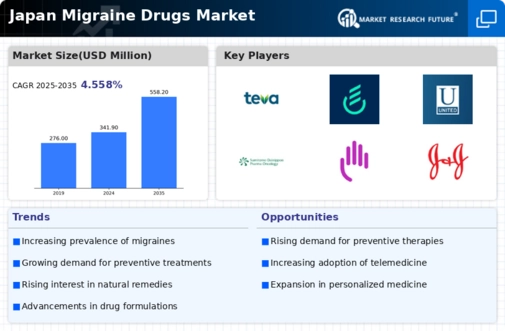Rising Healthcare Expenditure
The increase in healthcare expenditure in Japan is a significant driver for the migraine drugs market. As the government and private sectors allocate more resources to healthcare, there is a corresponding rise in spending on medications and treatments for chronic conditions, including migraines. In 2025, healthcare expenditure is projected to reach ¥50 trillion, reflecting a growing commitment to improving health outcomes. This financial investment enables better access to migraine treatments, including both over-the-counter and prescription medications. Additionally, as healthcare systems evolve, there is a greater emphasis on preventive care, which may lead to increased utilization of migraine drugs. This trend suggests a positive outlook for the migraine drugs market as healthcare spending continues to rise.
Advancements in Pharmaceutical Research
Innovations in pharmaceutical research are significantly influencing the migraine drugs market. The development of new drug formulations and delivery systems, such as CGRP inhibitors, has transformed treatment paradigms. These advancements not only enhance efficacy but also improve patient compliance. In Japan, the approval of novel therapies has led to a surge in treatment options, catering to diverse patient needs. The market is projected to witness a compound annual growth rate (CAGR) of around 6.5% over the next five years, driven by these research breakthroughs. Additionally, collaborations between pharmaceutical companies and research institutions are fostering an environment conducive to innovation, further propelling the migraine drugs market forward.
Regulatory Support for New Drug Approvals
Regulatory support in Japan plays a vital role in the growth of the migraine drugs market. The Pharmaceuticals and Medical Devices Agency (PMDA) has streamlined the approval process for new migraine therapies, encouraging pharmaceutical companies to invest in research and development. This supportive regulatory environment facilitates quicker access to innovative treatments for patients. As a result, the market is witnessing an influx of new products, including both traditional and novel therapies. The PMDA's commitment to expediting the approval of effective migraine medications is likely to enhance treatment options available to patients, thereby driving market growth. This regulatory landscape is essential for fostering innovation and ensuring that patients receive timely access to effective therapies.
Growing Awareness and Education Initiatives
In Japan, increasing awareness and education regarding migraine disorders are pivotal in shaping the migraine drugs market. Public health campaigns and educational programs aimed at both healthcare professionals and patients are enhancing understanding of migraine symptoms and treatment options. This heightened awareness encourages individuals to seek medical advice, leading to increased prescriptions for migraine medications. As a result, the market is experiencing a notable uptick in demand for both acute and preventive treatments. Furthermore, the Japanese government has recognized the importance of addressing migraine disorders, potentially allocating resources to support educational initiatives. This focus on awareness is likely to contribute to the overall growth of the migraine drugs market.
Increasing Prevalence of Migraine Disorders
The rising incidence of migraine disorders in Japan is a crucial driver for the migraine drugs market. Recent studies indicate that approximately 8.4% of the Japanese population suffers from migraines, with a notable prevalence among women. This growing patient base necessitates the development and availability of effective migraine treatments. As awareness of migraine disorders increases, more individuals seek medical assistance, thereby driving demand for various therapeutic options. The migraine drugs market is expected to expand as healthcare providers focus on innovative solutions to address this widespread issue. Furthermore, the economic burden associated with migraines, estimated at ¥1.2 trillion annually in lost productivity, underscores the need for effective interventions, making this a pivotal factor in the market's growth trajectory.




















Leave a Comment